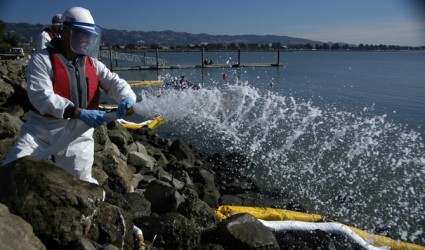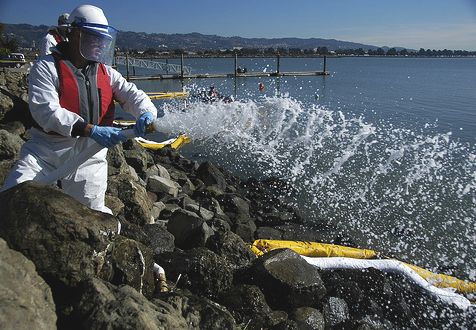 Coast Guard workers spray Corexit in a 2007 Berkeley, California, cleanup. It is not yet being used on Gulf of Mexico beaches. (U.S. Coast Guard photo)We finally know the main two dispersants that BP and the U.S. government are using to treat the ongoing Gulf spill. Both, by their maker’s own admission, have the “potential to bioconcentrate,” and both have “moderate toxicity to early life stages of fish, crustaceans, and mollusks,” according to a study by Exxon, the company that originally developed them. Their use may be the least-bad course, given the importance of minimizing oil’s effect on coastal wetlands. But a little digging into the chemical makeup of these two substances, which are being dumped in vast quantities into the Gulf, reveals that they could potentially do far more harm than good, both to the Gulf and to humans who later eat from it.
Coast Guard workers spray Corexit in a 2007 Berkeley, California, cleanup. It is not yet being used on Gulf of Mexico beaches. (U.S. Coast Guard photo)We finally know the main two dispersants that BP and the U.S. government are using to treat the ongoing Gulf spill. Both, by their maker’s own admission, have the “potential to bioconcentrate,” and both have “moderate toxicity to early life stages of fish, crustaceans, and mollusks,” according to a study by Exxon, the company that originally developed them. Their use may be the least-bad course, given the importance of minimizing oil’s effect on coastal wetlands. But a little digging into the chemical makeup of these two substances, which are being dumped in vast quantities into the Gulf, reveals that they could potentially do far more harm than good, both to the Gulf and to humans who later eat from it.
As ProPublica reported Monday, information about dispersants is “kept secret under competitive trade laws.” I’ve spent the last several days trying to confirm what many in the ocean-ecology and public health worlds seemed to know, but no one would say officially: that two different dispersants sold under the banner of Corexit were being used in vast quantities. The Corexit brand is owned by an Illinois-based company called Nalco, which entered the dispersant business back in 1994, when it merged with Exxon’s chemical unit. (By 2004, Exxon had divested and Nalco was a standalone company, according to Nalco’s company history.)
Last night I finally got my confirmation. A spokesperson for the Occupational Safety and Health Administration finally pointed me to the website of Deepwater Horizon Response, the U.S. government’s “ongoing administration-wide response to the Deepwater BP Oil Spill.” (Update: Now here.) The link took me to a “fact sheets” page, where I was able to download Nalco’s Material Safety Data Sheets for “Dispersant Type 1,” Corexit 9500 (PDF); and “Dispersant Type 2,” Corexit 9527A (PDF). These product numbers matched the ones that had been identified unofficially by my sources.
Bioconcentration game
OSHA requires companies to make Material Safety Data Sheets, or MSDSs, available for any hazardous substances used in a workplace, and the ones for these dispersants both contain versions of a disturbing statement. 9500’s states that “Component substances have a potential to bioconcentrate,” while the one for 9527A has the slightly more comforting, “Component substances have a low potential to bioconcentrate.”
This is not what you want to hear about toxins being dumped in the sea by the hundreds of thousands of gallons. The EPA defines bioconcentration as the “accumulation of a chemical in tissues of a fish or other organism to levels greater than in the surrounding medium.” In other words, substances that bioconcentrate tend to move from water into fish, where they can do damage to the fish itself, as well as be passed on to predator fish — and on up the food chain, to human eaters.
And just how toxic is this stuff? The data sheets for both products contain this shocker: “No toxicity studies have been conducted on this product” — meaning testing their safety for humans.
This is jaw-dropping. According to Ronald Tjeerdema, chair of the Department of Environmental Toxicology at UC Davis’ College of Agricultural & Environmental Sciences, who has been studying dispersants since the ’90s, “The industry typically only stockpiles one or two of these things,” and while Corexit 9527 has been the dispersant of choice for a long time, in recent years, Corexit 9500 has gained prominence. Yet Nalco has done no toxicity studies on these industry-dominating products now in heavy use in the Gulf?
They do appear to have toxic properties. Both data sheets include the warning “human health hazards: acute.” The MSDS for Corexit 9527A states that “excessive exposure may cause central nervous system effects, nausea, vomiting, anesthetic or narcotic effects,” and “repeated or excessive exposure to butoxyethanol [an active ingredient] may cause injury to red blood cells (hemolysis), kidney or the liver.”
It adds: “Prolonged and/or repeated exposure through inhalation or extensive skin contact with EGBE [butoxyethanol] may result in damage to the blood and kidneys.”
Just the surfactants, please
So, what’s in the stuff? According to their data sheets, both 9500 and 9527 are composed of three potentially hazardous substances. They share two in common, organic sulfonic acid salt and propylene glycol. In addition to those two, Corexit 9500 contains something called “Distillates, petroleum, hydrotreated light,” while Corexit 9527 contains 2-Butoxyethanol. Frustratingly, the sheets don’t give exact information about how much of the substances are in the dispersants; instead they give ranges as a percentage of weight. For example, Corexit 9500 can be composed of anywhere from 10 to 30 percent petroleum distillates, while 2-Butoxyethanol makes up anywhere from 30 to 60 percent of 9527.
Petroleum distillates and 2-Butoxyethanol are both solvents; neither are substances you’d excitedly dump into a vibrant ecosytem. According to its International Chemical Scorecard, 2-Butoxyethanol “may be absorbed” by the skin; causes “cough, dizziness, drowsiness, headache, nausea, and weakness” when inhaled; and “abdominal pain, diarrhea, nausea, and vomiting” when ingested. For petroleum distillates, the International Chemical Scorecard has similar indications about exposure for humans, and adds this unsettling line: “The substance is harmful to aquatic organisms.”
As for the two ingredients common to Corexit 9500 and Corexit 9527A, propylene glycol doesn’t seem horrendously toxic, according to its International Chemical Scorecard; while organic sulfonic acid salt is a bit of a black box. For the other substances, the data sheets listed what’s called a CAS number, which allows researchers to look up specific information. For organic sulfonic acid salt, the word “proprietary” appears in place of a CAS number.
Those things are surfactants, the detergents that bind to both oil and water and break oil down. It’s the solvents — 2-Butoxyethanol and petroleum distillate — that appear to be the most dangerous. Tjeerdema of UC Davis told me that the surfactants now in use are detergents “very much like you use to wash your dishes” and “don’t have significant ability to bioconcentrate.” The solvents are a different story. He said their role in a dispersant is to help the surfactants mix with water. “It could be an issue that the solvents are able to bioaccumulate,” he said.
Meanwhile, on Wednesday, the Coast Guard dropped 150,000 gallons of this stuff on the spill surface, AP reports. I talked to a BP spokesman Thursday morning. He told me the company planned to continue using dispersants at the surface. The tactic of applying near the spill at the ocean floor has been temporarily suspended, the BP spokesperson said. He wouldn’t divulge why.
Tjeerdema explained that the tactic of applying dispersant underwater at the base of leak is a “unique situation” because dispersants are normally applied at the surface. “The hope is that the dispersants and oil mix as they rise and lessen the amount of oil that reaches the surface,” he said. Mixing is key to achieving that goal, he continued, and mixing occurs best at warm temperatures. “At 5,000 feet below the surface, the temperature is a lot colder and there’s a lot more pressure, and both the dispersant and the oil are thicker and more viscous,” he said. “My guess is that the mixing down low isn’t happening very readily … I would be concerned that they’re not very mixable because of the temperature.”
If they don’t mix well, of course, BP was until recently dumping toxic chemicals into the Gulf without gaining any advantage in limiting damage from the spill. According to a report on Wednesday, a “brown slime” appeared on the shore of a barrier island off Louisiana. “The slime, which is not as thick as oil, is thought to be the chemical dispersant that had been pumped down to the site of the leak to break up the oil before it reached the surface,” ABC reported.
As Tjeerdema told me, there are no good options for containing the spill until the leak is closed. Unfortunately, that won’t happen for months. And until then, we are likely further damaging to a fragile ecosystem in the name of saving it, and imperiling the health of seafood eaters for years to come.



